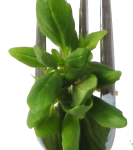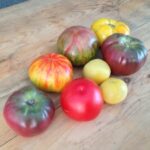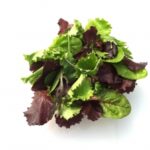News
Five Deliciously Unusual Fruit & Veggie Grilling Ideas!
Labor Day weekend is here, and with it the season’s last official ‘grill-worthy’ holiday. Today we take a look at five of the more unusual grilling options for in-season fruits and vegetables! Potatoes Sick of the same old boring potato salad? Liven things up with grilled potatoes! From grilled potato fries to grilled southwestern potato…
Read More »The Joys of Potato Farming
Each year in early August, something special happens here at Blue Moon Acres. Our Pennington, NJ farmers head for the fields and start hunting for buried treasure. Not gold, silver, or jewels, but a more edible kind of treasure: potatoes. It’s a magical experience, pulling those first few tubers from the ground—the sweet, earthy smell;…
Read More »Ode to Summer Savory
One of the perks of writing the product descriptions for Blue Moon’s weekly newsletters is getting to sample those products. This was especially true last week, when I had the pleasure to try the season’s first offering of Summer Savory. I was struck by the thymey, oreganoy flavor; the mild numbing effect it had on…
Read More »A Brief History of Tomatoes
High summer is here, and you know what that means: fresh, local tomatoes. If you don’t have plants of your own, you probably know someone who does. Whether transformed into your favorite sauce or salsa, or simply eaten whole with a little salt, tomatoes are one of the season’s most rewarding edible treasures. And to…
Read More »Five Ways to Deter Garden Pests!
Summer’s here and your garden’s in full swing. And so are those pesky garden pests, working overtime to make a mockery of all your hard work. Today we discuss 5 safe and natural ways to keep those pests at bay. 1. Hot sauce and dish detergent Would you enjoy a soapy hot sauce dressing with…
Read More »The Vanishing Small Farm
Everywhere, all over the country, all around the world, small farms are disappearing. According to a USDA report, after peaking at 6.8 million in 1945, U.S. farms fell sharply until the early 1970s; by 2002, only 2.1 million farms remained. If you’ve lived long enough, chances are you remember a few of these small farms,…
Read More »Powered by Bicycle: The Future of Sustainable Farming
Everyone knows bikes are a great way to exercise, enjoy the outdoors, or even commute. But did you know bikes can be converted into useful agricultural tools and machines? From weeding, harvesting, planting, threshing, shelling, winnowing—bikes can do it all. And without greenhouse emissions and expensive repair bills. The following are a few ways that…
Read More »The Mysterious and Fascinating Life of Roots
When we think of roots, most of us think of pale, fibrous, slimy-looking tubes whose only purpose is sucking water out of soil. If we’re gardeners or farmers, we also think of roots as food. But roots do much more than siphon water and provide food—they’re the cornerstone of plant function. And in many ways…
Read More »T’is the Season for Spring Mix
The growing season is ramping up, and you know what that means: spring mix! Each year around this time, we see our first delicious harvest of this delicious crop. The variety of fresh tastes and textures are welcome after a long and cold winter. But just what is spring mix? And where does it come…
Read More »What are Phytonutrients?
Spend enough time reading health blogs and you’ll probably come across the word, ‘phytonutrients’. It’s a term that’s often used in conjunction with physical fitness and nutritional health. But what are phytonutrients? How do they work? And why should you care? Phytonutrients are actually a little difficult to pin down. Google defines them as ‘a…
Read More »









